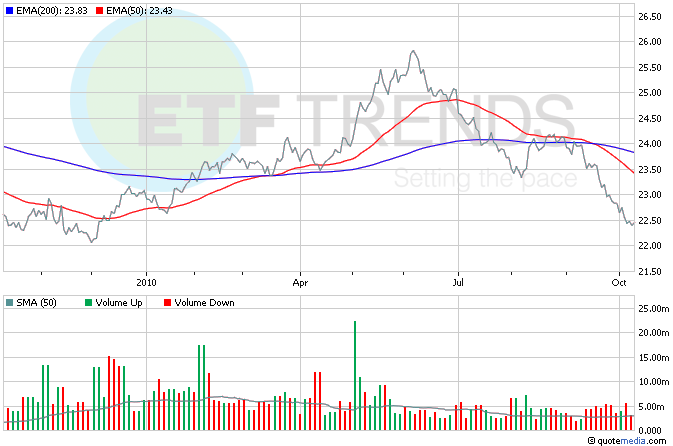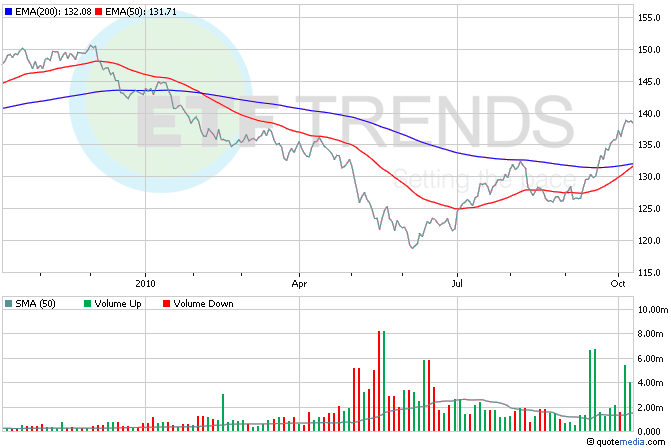Trading in Currency ETFs
Post on: 28 Апрель, 2015 No Comment

Trading in Currency ETFs
The exchange-traded fund, or ETF, can be tremendously valuable to the short-term trader. They offer many of the advantages of mutual funds—primarily the ability to invest in an entire sector, sub-sector, market, or foreign country, as a few examples, along with low expenses (virtually all ETFs are passively managed, like an index mutual fund) and reduced tax liability resulting from fewer capital gains.
Yet unlike a mutual fund, the ETF trades throughout the session, and its price floats accordingly. Mutual funds are priced only once a day at the end of the session, when the net asset value is determined based on the closing prices of all securities held in the fund. Minimum investments are typically quite large as well. This makes them unsuitable for short-term trading, so the ETF is an ideal substitute for the mutual fund.
Equity ETFs offer a tremendous range of options that can be employed in a variety of trading strategies. However, there are other flavors of ETF that are slightly more exotic. Here we’ll consider the currency ETF.
Forex (foreign exchange) trading is a hot area for short-term and day traders, but there are fundamental differences between forex and equity trading. If you are interested in the currency markets but would like to ease into such trading, currency ETFs can be a great way to cut your teeth.
As it happens, currency ETFs are best-suited for shorter-term trading strategies, speculation, and hedging, though somewhat less so for intraday trading. Over the long term, diversifying out of U.S. dollar holdings is better accomplished with international equity or bond funds or ETFs.
The most basic play with currency ETFs is speculating on the direction of the U.S. dollar. This can be accomplished with the PowerShares DB U.S. Dollar Bullish Fund (UUP ) or the PowerShares DB U.S. Dollar Bearish Fund (UDN ). Similarly, you can purchase ETFs that track the British pound, euro, Japanese yen, Canadian dollar, Swiss franc, Australian dollar, and other major currencies.
Broadly speaking, currencies tend to move in price channels, not appreciate over the long term like equities—one of the key differences between the forex and equity markets. Movements are often predictable, since factors such as government policies, central bank interest rate policies, economic growth, and inflation are the main drivers of currency values. All of this is information that is readily available and heavily analyzed.
Specific economic factors also drive certain currencies. Some are tied closely to commodities. For example, the Canadian dollar consistently moves with oil prices. (Despite all the talk in the media about Middle East oil, Canada is actually the number-one source of imported oil for the U.S.) Exposure to the Canadian dollar can be achieved with the CurrencyShares Canadian Dollar Trust (FXC ).
Other commodity linkages include both the Australian dollar and the New Zealand dollar with gold. For Australia, this linkage results from the fact that it is the world’s third-largest producer of gold, and the positive correlation between the two (meaning the Australian dollar rises when gold does) is over 80%. New Zealand benefits by proxy since its economy is closely tied to Australia’s, and its currency is positively correlated with gold by over 75%. (The correlation between the two currencies, meanwhile, is in the upper 90 th percentile.) The Australian dollar is tradable using the CurrencyShares Australian Dollar Trust (FXA ).

An alternative (or additional) play with commodity price movements involves buying the currency that benefits and shorting the one that suffers. With oil, for example, we have seen that the Canadian dollar benefits from rising prices, but the Japanese yen would suffer since Japan is a heavy importer of oil. This allows you to make parallel trades—one long position, one short position—to take advantage of an expected increase in oil.
The Swiss franc, by contrast, is strongly influenced by interest rate movements. It is inversely correlated with the 10-year U.S. Treasury yield (meaning the franc rises when the bond rate falls and vice versa). Since U.S. government bonds have been at historically low yields recently, one potential play should rates finally start to rise would be shorting the CurrencyShares Swiss Franc Trust (FXF ).
As you can see, currency ETFs offer a great means of playing short- and medium-term trends in international economic conditions and currencies without plunging directly into the forex marketplace. This is particularly valuable for the trader who is accustomed to—and more comfortable with—equity trading.














